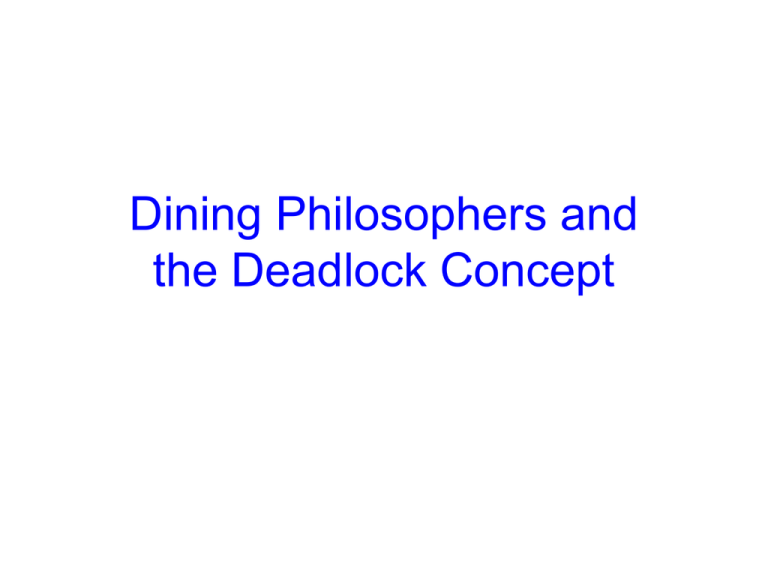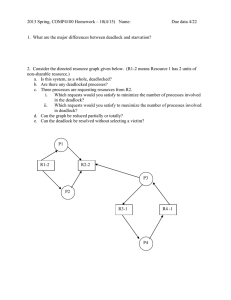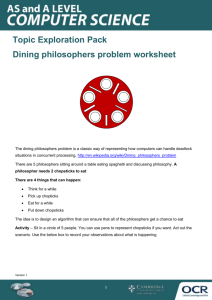Dining Philosophers and the Deadlock Concept
advertisement

Dining Philosophers and
the Deadlock Concept
Announcements
• Homework 2 and Project 2 Design Doc due Today
– Make sure to look at the lecture schedule to keep up with
due dates!
• Prelim coming up in two and a half weeks:
–
–
–
–
Thursday March 8th, 7:30—9:00pm, 1½ hour exam
203 Phillips
Closed book, no calculators/PDAs/…
Bring ID
– Topics: Everything up to (and including) Monday, March 5th
• Lectures 1-18, chapters 1-9 (7th ed)
– Review Session: Scheduling either night of Monday, March
5th or Tuesday, March 6th
So far…
• We’ve focused on two styles of
communication
• Bounded buffer: sits between producers
and consumers
– Used widely in O/S to smooth out rate
mismatches and to promote modularity
• Readers and writers
– Models idea of a shared data object that
threads read and sometimes update
Dining Philosophers
• A problem that was invented to illustrate a
different aspect of communication
• Our focus here is on the notion of sharing
resources that only one user at a time can
own
– Such as a keyboard on a machine with many
processes active at the same time
– Or a special disk file that only one can write at
a time (bounded buffer is an instance)
Dining Philosopher’s Problem
• Dijkstra
• Philosophers eat/think
• Eating needs two forks
• Pick one fork at a time
Idea is to capture the concept of multiple processes
competing for limited resources
Rules of the Game
• The philosophers are very logical
– They want to settle on a shared policy that all
can apply concurrently
– They are hungry: the policy should let
everyone eat (eventually)
– They are utterly dedicated to the proposition
of equality: the policy should be totally fair
What can go wrong?
• Primarily, we worry about:
– Starvation: A policy that can leave some
philosopher hungry in some situation (even
one where the others collaborate)
– Deadlock: A policy that leaves all the
philosophers “stuck”, so that nobody can do
anything at all
– Livelock: A policy that makes them all do
something endlessly without ever eating!
Starvation vs Deadlock
• Starvation vs. Deadlock
– Starvation: thread waits indefinitely
• Example, low-priority thread waiting for resources constantly
in use by high-priority threads
– Deadlock: circular waiting for resources
• Thread A owns Res 1 and is waiting for Res 2
Thread B owns Res 2 and is waiting for Res 1
Owned
By
Thread
A
Res 2
Res 1
Wait
For
Wait
For
Thread
B
Owned
By
– Deadlock Starvation but not vice versa
• Starvation can end (but doesn’t have to)
• Deadlock can’t end without external intervention
A flawed conceptual solution
# define N
5
Philosopher i (0, 1, .. 4)
do {
think();
take_fork(i);
take_fork((i+1)%N);
eat(); /* yummy */
put_fork(i);
put_fork((i+1)%N);
} while (true);
Coding our flawed solution?
Shared: semaphore fork[5];
Init: fork[i] = 1 for all i=0 .. 4
Philosopher i
do {
P(fork[i]);
P(fork[i+1]);
/* eat */
V(fork[i]);
V(fork[i+1]);
/* think */
} while(true);
Oops! Subject
to deadlock if
they all pick up
their “right” fork
simultaneously!
Dining Philosophers Solutions
• Allow only 4 philosophers to sit simultaneously
• Asymmetric solution
– Odd philosopher picks left fork followed by right
– Even philosopher does vice versa
• Pass a token
• Allow philosopher to pick fork only if both available
One Possible Solution
• Introduce state variable
– enum {thinking, hungry, eating}
• Philosopher i can set the variable state[i]
only if neighbors not eating
– (state[(i+4)%5] != eating) and
(state[(i+1)%5]!= eating
• Also, need to declare semaphore self,
where philosopher i can delay itself.
One possible solution
Shared: int state[5], semaphore s[5], semaphore mutex;
Init: mutex = 1; s[i] = 0 for all i=0 .. 4
Philosopher i
do {
take_fork(i);
/* eat */
put_fork(i);
/* think */
} while(true);
take_fork(i) {
P(mutex);
state[i] = hungry;
test(i);
V(mutex);
P(s[i]);
}
put_fork(i) {
P(mutex);
state[i] = thinking;
test((i+1)%N);
test((i-1+N)%N);
V(mutex);
}
test(i) {
if(state[i] == hungry
&& state[(i+1)%N] != eating
&& state[(i-1+N)%N != eating)
{
state[i] = eating;
V(s[i]);
}
Solutions are less interesting than
the problem itself!
• In fact the problem statement is why
people like to talk about this problem!
• Rather than solving Dining Philosophers,
we should use it to understand properties
of solutions that work and of solutions that
can fail!
Cyclic wait
• For example… consider a deadlock
– Each philosopher is holding one fork
– … and each is waiting for a neighbor to
release one fork
• We can represent this as a graph in which
– Nodes represent philosophers
– Edges represent waiting-for
Cyclic wait
Cyclic wait
• We can define a system to be in a deadlock
state if
– There exists ANY group of processes, such that
– Each process in the group is waiting for some other
process
– And the wait-for graph has a cycle
• Doesn’t require that every process be stuck…
even two is enough to say that the system as a
whole contains a deadlock (“is deadlocked”)
What about livelock?
• This is harder to express
– The issue is that processes may be active and yet are
“actually” waiting for one-another in some sense
– Need to talk about whether or not processes make
progress
– Once we do this, starvation can also be formalized
• These problems can be solved… but not today
• In CS414 we’ll limit ourselves to deadlock
– Detection: For example, build a graph and check for
cycles (not hard to do)
– Avoidance – we’ll look at several ways to avoid
getting into trouble in the first place!
Real World Deadlocks?
• Truck A has to wait
for truck B to
move
• Not
deadlocked
Real World Deadlocks?
• Gridlock
Real World Deadlocks?
• Gridlock
The strange story of “priorité a droite”
• France has many traffic circles…
– … normally, the priority rule is that a vehicle trying to enter must
yield to one trying to exit
– Can deadlock occur in this case?
• But there are two that operate differently
– Place Etoile and Place Victor Hugo, in Paris
– What happens in practice?
• In Belgium, all incoming roads from the right have priority
unless otherwise marked, even if the incoming road is
small and you are on a main road.
– This is useful to remember.
– Is the entire country deadlock-prone?
Testing for deadlock
• Steps
– Collect “process state” and use it to build a
graph
• Ask each process “are you waiting for anything”?
• Put an edge in the graph if so
– We need to do this in a single instant of time,
not while things might be changing
• Now need a way to test for cycles in our
graph
Testing for deadlock
• How do cars do it?
– Never block an intersection
– Must back up if you find yourself doing so
• Why does this work?
– “Breaks” a wait-for relationship
– Illustrates a sense in which intransigent
waiting (refusing to release a resource) is one
key element of true deadlock!
Testing for deadlock
• One way to find cycles
– Look for a node with no outgoing edges
– Erase this node, and also erase any edges
coming into it
• Idea: This was a process people might have been
waiting for, but it wasn’t waiting for anything else
– If (and only if) the graph has no cycles, we’ll
eventually be able to erase the whole graph!
• This is called a graph reduction algorithm
Graph reduction example
0
8
3
4
This graph can be “fully reduced”, hence
2
there was no deadlock
at the time the graph
was drawn.
7
Obviously, things could change later! 11
1
5
9
10
12
6
Graph reduction example
• This is an example of
an “irreducible” graph
• It contains a cycle
and represents a
deadlock, although
only some processes
are in the cycle
What about “resource” waits?
• When dining philosophers wait for oneanother, they don’t do so directly
– Erasmus doesn’t “wait” for Ptolemy
• Instead, they wait for resources
– Erasmus waits for a fork… which Ptolemy
exclusively holds
• Can we extend our graphs to represent
resource wait?
Resource-wait graphs
• We’ll use two kinds of nodes
• A process: P3 will be represented as:
3
• A resource: R7 will be represented as:
– A resource often has multiple identical
units, such as “blocks of memory”
– Represent these as circles in the box
• Arrow from a process to a resource: “I want
k units of this resource.” Arrow to a process:
this process holds k units of the resource
– P3 wants 2 units of R7
2
7
A tricky choice…
• When should resources be treated as “different
classes”?
– To be in the same class, resources do need to be
equivalent
• “memory pages” are different from “forks”
– But for some purposes, we might want to split
memory pages into two groups
• The main group of forks. The extra forks
– Keep this in mind next week when we talk about ways
of avoiding deadlock.
• It proves useful in doing “ordered resource allocation”
Resource-wait graphs
1
2
4
3
2
1
1
1
2
5
1
4
Reduction rules?
• Find a process that can have all its current
requests satisfied (e.g. the “available amount” of
any resource it wants is at least enough to
satisfy the request)
• Erase that process (in effect: grant the request,
let it run, and eventually it will release the
resource)
• Continue until we either erase the graph or have
an irreducible component. In the latter case
we’ve identified a deadlock
This graph is reducible: The system
is not deadlocked
1
2
4
3
2
1
1
1
2
1
1
4
This graph is not reducible: The
system is deadlocked
3
2
1
1
2
1
2
1
5
1
4
4
Comments
• It isn’t common for systems to actually
implement this kind of test
• However, we’ll use a version of the
resource reduction graph as part of an
algorithm called the “Banker’s Algorithm”
later in the week
• Idea is to schedule the granting of
resources so as to avoid potentially
deadlock states
Some questions you might ask
• Does the order in which we do the
reduction matter?
– Answer: No. The reason is that if a node is a
candidate for reduction at step i, and we don’t
pick it, it remains a candidate for reduction at
step i+1
– Thus eventually, no matter what order we do it
in, we’ll reduce by every node where
reduction is feasible
Some questions you might ask
• If a system is deadlocked, could this go away?
– No, unless someone kills one of the threads or
something causes a process to release a resource
– Many real systems put time limits on “waiting”
precisely for this reason. When a process gets a
timeout exception, it gives up waiting and this also
can eliminate the deadlock
– But that process may be forced to terminate itself
because often, if a process can’t get what it needs,
there are no other options available!
Some questions you might ask
• Suppose a system isn’t deadlocked at time
T.
• Can we assume it will still be free of
deadlock at time T+1?
– No, because the very next thing it might do is
to run some process that will request a
resource…
… establishing a cyclic wait
… and causing deadlock


